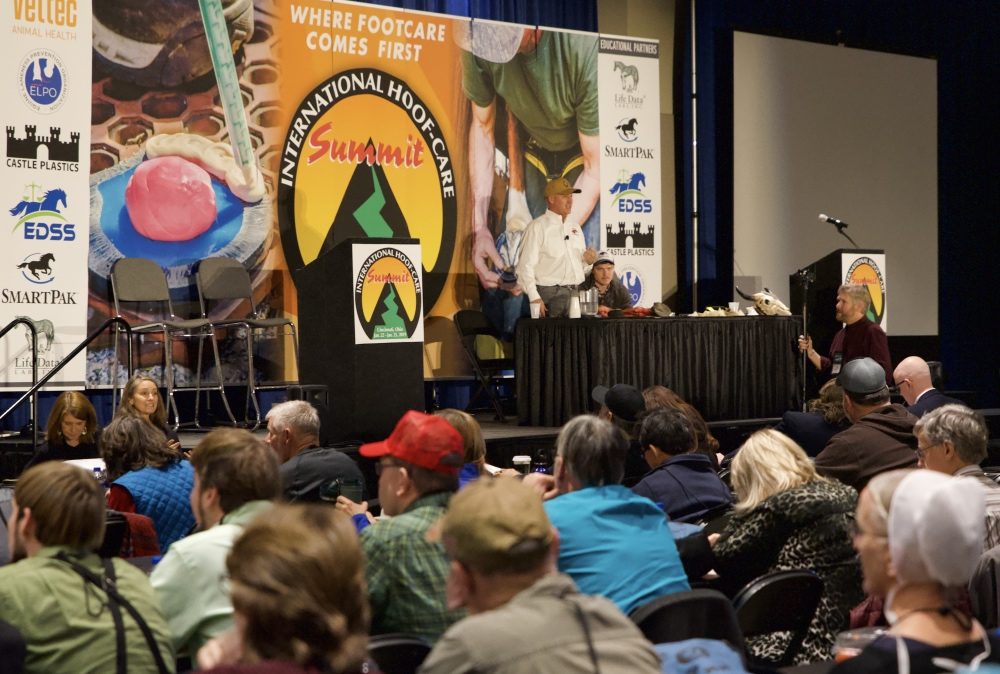The Ohio State Veterinary Medical Licensing Board has approved the 2020 International Hoof-Care Summit (IHCS) for continuing education credits.
Veterinarians, vet techs and farriers can learn the latest about the techniques, medications and research relating to hoof care while earning CE hours.
Dr. Frank K. Reilly, a Pennsylvania-based veterinarian, has attended the IHCS for the past 9 years. Each time he includes the educational sessions in his CE report for his license renewal. He is a licensed veterinarian in Pennsylvania, Delaware and Maryland.
“I have submitted CE credits to various states that I have a license for and they have been accepted — every state, every year,” he says.
The Ohio State Veterinary Medical Licensing Board has approved the 2020 Summit for 23 continuing education credits. That means those with Ohio licenses will have the easiest time submitting for credit. There isn’t direct reciprocity in continuing education regulations between state boards, explains Dr. M.W. “Tookie” Myers, a Virginia-based veterinarian who also practices in North Carolina. Other states may require pre-approval before participation and/or more detailed submission information. Here is a look at some of the states that require preliminary documentation.
States that have no forms. Georgia, Indiana and Texas. Indiana recommends calling before applying, while Texas requires that the board be called for details of pre-approval. Forms from other states can be used in those that don’t have a specific form.
States that have forms. Kentucky, Michigan, North Carolina, New York, Pennsylvania and West Virginia. Pennsylvania requires a call to the board in advance.
In many cases, Reilly adds, the process is an honor system that’s not closely scrutinized by the state licensing boards. He has found that the state boards only question CE credit submissions when they have reason to believe there is an issue with the information submitted.
AAPF, CAPF or IAPF Members ...
You will receive 27 continuing education credit hours if you are registered for the entire Summit. These will automatically be applied to your profile after the Summit. For questions regarding continuing education credits, contact Bryan Quinsey at bryan@professionalfarriers.com or (859) 533-1465.
“When you submit your license and continuing education credits, you have to sign that you’re being truthful,” he says. “If they have reason to believe you’re not being truthful and find that to be the case, then they can pull your license.”
The number of CE credits and frequency of the licensing renewal process differs from state to state. Sections 6704-a and 6711-b of the New York Education Law, respectively, require veterinarians to complete 45 hours and veterinary technicians to complete 24 hours of acceptable continuing education every 3 years. Section 62.8 of the Regulations of the Commissioner of Education further specifies the continuing education requirements for both veterinarians and veterinary technicians (For more, visit americanfarriers.com/topics/118-conference-updates). On the opposite U.S. coast, California law requires veterinarians to earn a minimum of 36 hours of approved continuing education as a condition of license renewal. The continuing education credits must be earned in the 2 years preceding license renewal (For more, visit americanfarriers.com/topics/118-conference-updates).
Because the license renewal process and the state licensing board’s acceptance of CE credits can be drastically different, Myers and Reilly share their experiences with the CE credit submission process but encourage veterinarians to contact their state licensing board to confirm the process in their state.
CE Credit Submission
Each state licensing board has its own CE submission process. In California, veterinarians are responsible for assuring that approved providers offer CE courses before attending the sessions. CE providers must be approved in California statute or regulation or have RACE approval from the America Association of Veterinary State Boards (AAVSB) at aavsb.org.
The three states in which Reilly is licensed have a less formal process. There, he says, the process requires a form that identifies the training event attended, along with the license renewal form and fee. Typically, the state licensing board wants to know where the program was held, the date, the topic and the number of CE hours requested.
“These sheets are submitted to the appropriate State Veterinary Board and you sign that you are telling the truth about what CE event you attended and where you went for it,” says Reilly.
The states Reilly practices in operate on the honor system, but he recommends maintaining a file with supporting documents. When requesting credit hours for the IHCS, he saves a receipt for registration payment and plane tickets to prove arrival and departure dates. He also includes the hotel receipt and rental car or cab services as evidence of attendance. Then he lists all the educational sessions he attended each day but does not count the hours spent at the Roundtables, exhibits or the meetings conducted by the American Association of Professional Farriers.
“All of this I keep in a file and have ready if a veterinary board member has a question,” he says.
Myers cautions that because each state has its own guidelines and approval process, it’s important to check with the appropriate state board before the event. These regulations are subject to change at various times since the board of each state writes them.
Another option for submission is the AAVSB’s Veterinary Continuing Education Tracking (VCET) is a centralized database that can streamline the CE credit submission process. VCET is a free online program available to veterinary professionals and the AAVSB Member Organizations. Currently, the licensing boards in 23 states, the District of Columbia and two Canadian provinces (Prince Edward Island and Saskatchewan) accept CE credits submitted through VCET. Any licensed or credentialed veterinary professional can use the VCET service for free to record and track CE for those states that accept submissions through the system. Learn more about VCET and register for an account at aavsb.org/vcet.
Why IHCS for CE Credits?
Veterinarians and vet techs have many available opportunities for obtaining CE credits. Myers and Reilly encourage these professionals to attend the IHCS because of the importance of hoof care in the overall well-being of horses.
“There is a need for hoof-care education and how it benefits the horse,” Myers emphasizes. “This topic is only covered briefly in veterinary and technician schools but is needed to provide optimal care for horses.”
IHCS does more than provide education sessions that are vital to providing quality care. The Summit offers high-quality programming from hoof-care experts around the world.
“Blending farriers and veterinarians together at the IHCS is essential for exchanging ideas and coming up with solutions,” Reilly says. “For this to happen, attending the IHCS will help veterinarians collect their CE credits to maintain their license.”
In its 17th year, the International Hoof-Care Summit is the largest equine footcare conference in the world, and is annually held in Cincinnati, Ohio.








